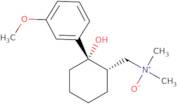Tramadol N-Oxide
CAS : 147441-56-3
Ref. 3D-XFA44156
| 5mg | Arrêté | ||
| 10mg | Arrêté | ||
| 25mg | Arrêté | ||
| 50mg | Arrêté | ||
| 100mg | Arrêté |
Informations sur le produit
- Cyclohexanol,2-[(dimethylamino)methyl]-1-(3-methoxyphenyl)-, N-oxide, cis-(?à)-
- Cyclohexanol,2-[(dimethyloxidoamino)methyl]-1-(3-methoxyphenyl)-, cis-
- Rwj 38705
- TramadolN-oxide
Tramadol N-oxide is a metabolite of tramadol that is formed in the liver. Tramadol N-oxide has been shown to have antinociceptive effects in rats, and it may be responsible for some side effects associated with tramadol, such as depression. Tramadol N-oxide is also known to be an analytical byproduct of wastewater treatment, which can cause false positives during drug testing due to its similar structure and mass. To avoid this issue, sample preparation techniques must be used before analysis. The detection limit of the analytical method used to measure Tramadol N-oxide was found to be 0.1 mg/L or 10 parts per billion. This compound can also be detected by spectrometric methods such as UV/VIS, IR, and MS. These methods are sensitive enough to detect concentrations at the parts per trillion level.





